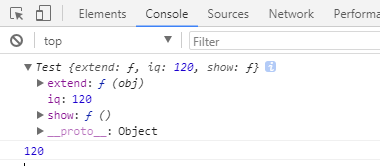call、apply
var test1 = document.getElementById("test1"); var test2 = document.getElementById("test2"); function t(){ console.log(arguments); this.style.background = 'gray'; } t.call(test1,1,2,1,2); /* 函数名.call(对象,参数) 1、把函数的this指向对象 2、运行函数,传递参数 //apply的参数是传递数组 */
闭包
/*作用域在声明时候已经决定了*/ var cnt=(function t(){ var age = 21;//局部变量 不会污染全局变量 return function(){//只有该函数可以访问局部变量 return age++; } })(); //防止函数污染 var $ = {}; $.cnt=cnt; console.log($.cnt()); console.log($.cnt()); console.log($.cnt()); console.log($.cnt());
私有属性
function Girl(name,age){ var name=name;//局部变量 var age=age; this.getlove=function(){ return name; } } var g = new Girl("test",21);//通过闭包完成私有属性封装 console.log(g.getlove()); //只能通过g的getlove属性获取局部变量
原型
function Cat(){ this.climb =function(){ console.log("爬行"); } } function Tiger(){ this.hunt=function(){ console.log("打猎"); } } Tiger.prototype = new Cat(); Tiger.prototype.song=function(){ //扩充原型行为 console.log("唱歌"); } var t = new Tiger(); //给 所有 对象添加这个行为 Object.prototype.say=function(){ console.log("hehe"); } var d = new Date(); d.say();//日期对象都有这个行为因为日期对象的最终原型也是Object t.hunt(); t.climb(); t.song(); //console.log(new Cat()); //console.log(Tiger.prototype); console.log(t.__proto__);//原型是猫对象 console.log(t.__proto__.__proto__);//原型是空对象 console.log(t.__proto__.__proto__.__proto__);//原型是最原始的对象 console.log(t.__proto__.__proto__.__proto__.__proto__);//原型为null

原型冒充(相当于继承过来)
function Good(){ this.iq=120; } function Bad(){ Good.call(this); this.show =function(){ console.log(this.iq); } } var b = new Bad(); b.show();
结果:

复制继承
function Good(){ this.iq=120; } function Bad(){ Good.call(this); this.show =function(){ console.log(this.iq); } } function Test(){ this.extend=function(obj){ for(var key in obj){ this[key] = obj[key]; } } } var b = new Bad(); var t = new Test(); t.extend(b); console.log(t); b.show();

函数本身也是对象
函数.length为参数个数
函数.name函数名称